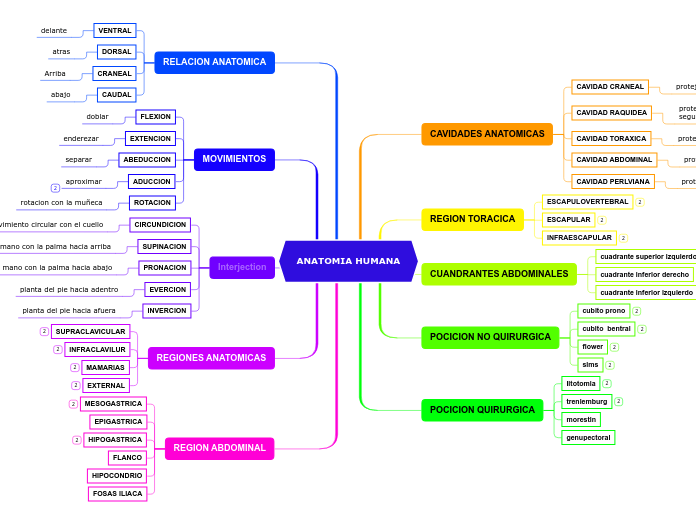ANATOMIA HUMANA
The part of speech is a category to which a word is assigned according to its syntactic functions. In English the main parts of speech are noun, pronoun, adjective, determiner, verb, adverb, preposition, conjunction, and interjection.
REGION ABDOMINAL
A conjunction is a word like 'if' 'but' or 'and' which is used to connect sentences or clauses together.
FOSAS ILIACA
HIPOCONDRIO
FLANCO
HIPOGASTRICA
Subordinating conjunctions are conjunctions that are used at the beginning of subordinate clauses. Some examples of these conjunctions are: although, after, before, because, how, if, once, since, so that, until, unless, when etc.
Although it was raining, I went out.
EPIGASTRICA
MESOGASTRICA
Coordinating conjunctions always connect phrases, words, and clauses. They are: for, and, nor, but, or, yet, so.
This stew is savory and delicious.
REGIONES ANATOMICAS
A preposition is one of the most exciting parts of grammar. A preposition is used to describe the location of something in relation to something else.
EXTERNAL
Participle preposition consists of words that end in “ing”.
regarding, barring, concerning, considering, etc.
MAMARIAS
When a preposition consists of more than one word, it is called double preposition.
into, within, upto etc.
INFRACLAVILUR
Compound preposition consists of two or more words.
on behalf of, according to, in front of, from across, etc.
SUPRACLAVICULAR
When a preposition consists of one word it is called single or simple preposition.
in, at, on, to for, of, from, up, after, over, under, with, etc.
Interjection
An interjection is used to express emotion in a sentence.
Think of other interjections!
INVERCION
planta del pie hacia afuera
EVERCION
planta del pie hacia adentro
PRONACION
mano con la palma hacia abajo
SUPINACION
mano con la palma hacia arriba
CIRCUNDICION
movimiento circular con el cuello
MOVIMIENTOS
An adverb is used to describe a verb, but it can also describe an adjective or another adverb.
Adverbs normally help paint a fuller picture by describing how something happens.
ROTACION
rotacion con la muñeca
ADUCCION
The intensifiers strengthen adverbs adjectives and adverbs and down- toners make them weaker.
aproximar
Extremely, Very
ABEDUCCION
separar
EXTENCION
enderezar
FLEXION
doblar
RELACION ANATOMICA
A numeral is a word or phrase that describes a numerical quantity.
Some theories of grammar use the word 'numeral' to refer to cardinal numbers that act as a determiner to specify the quantity of a noun, for example the 'two' in 'two hats'.
CAUDAL
abajo
CRANEAL
Arriba
DORSAL
atras
VENTRAL
delante
POCICION QUIRURGICA
An article is a word used to modify a noun, which is a person, place, object, or idea. Technically, an article is an adjective, which is any word that modifies a noun.
genupectoral
morestin
trenlemburg
Indefinite articles are the words 'a' and 'an.' Each of these articles is used to refer to a noun, but the noun being referred to is not a specific person, place, object, or idea. It can be any noun from a group of nouns.
A car in the parking lot.
litotomia
It refers directly to a specific noun or groups of nouns.
The breakfast on my plate.
POCICION NO QUIRURGICA
A pronoun is a word that can be used in place of a noun, typically after the noun itself has already been stated.
sims
A reflexive pronoun ends with ...self or ...selves and refers to another noun or pronoun in the sentence (usually the subject of the sentence). The reflexive pronouns are myself, yourself, herself, himself, itself, ourselves, yourselves, and themselves.
Itself, Himself
flower
Demonstrative pronouns are used to demonstrate (or indicate). This, that, these, and those are all demonstrative pronouns.
This, These
cubito bentral
Possessive pronouns are used to show possession. The possessive pronouns are mine, yours, his, hers, ours, and theirs.
His, Your
cubito prono
The personal pronouns are I, you, he, she, it, we, they. More often than not (but certainly not always), they replace nouns representing people.
He, They
CUANDRANTES ABDOMINALES
An adjective is a word that's used to describe a specific noun and to provide more detail to the listener.
cuadrante inferior izquierdo
cuadrante inferior derecho
cuadrante superior izquierdo
REGION TORACICA
A noun is defined as a person, place, thing or idea. Proper nouns always begin with a capital letter. Common nouns, which are general words, such as 'cars,' are not capitalized.
INFRAESCAPULAR
Compound nouns are words where two nouns have been stuck together to make a new noun. Compound nouns should be written as one word, without a hyphen.
Candlestick
ESCAPULAR
A noun which refers to a group of things/people.
Family, Class
ESCAPULOVERTEBRAL
Countable nouns are nouns that can be counted, even if the number might be extraordinarily high.
Uncountable nouns are nouns that come in a state or quantity which is impossible to count; liquids are uncountable, as are things which act
like liquids.
Create sentences
Cats, Rain
CAVIDADES ANATOMICAS
A verb is an action word or 'doing' word that signifies movement in some way.
CAVIDAD PERLVIANA
An auxiliary verb helps the main (full) verb and is also called a 'helping verb.' With auxiliary verbs, you can write sentences in different tenses, moods, or voices.
proteje los genitales,los ovulos,utero,trompas
CAVIDAD ABDOMINAL
A participle is a verb form that can be used as an adjective or to create a verb tense. There are two types of participles: Present participle (ending -ing) and Past participle (usually ending -ed, -d, -t, -en, or -n).
proteje tejidos de la piel y musculos
CAVIDAD TORAXICA
A modal is a type of auxiliary (helping) verb that is used to express: ability, possibility, permission or obligation. The main modal verbs in the English language are: can, could, may, might, must, shall, should, will, would.
proteje el corazon y los pulmones
CAVIDAD RAQUIDEA
A linking verb connects the subject with a word that gives information about the subject, such as a condition or relationship.
proteje la medula espinal que llega hasta la segunda medula lumbral
CAVIDAD CRANEAL
A verb with its own meaning: a verb that is not an auxiliary verb.
proteje el craneo









